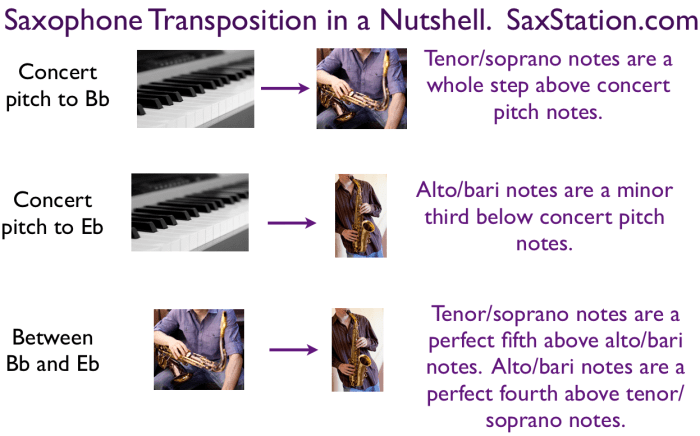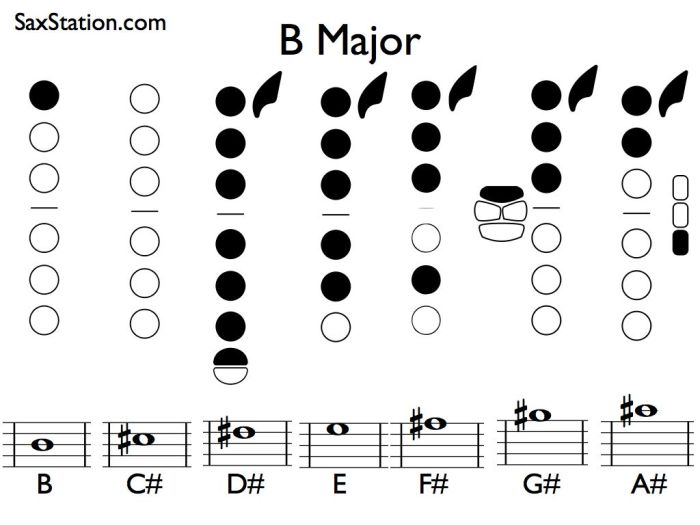Prepare to embark on a musical odyssey with the alto sax 12 major scales! From fingering patterns to improvisation techniques, this guide will empower you to unlock the full potential of your instrument.
Mastering these scales is not just about technical proficiency; it’s about expanding your musical vocabulary and unlocking a world of creative possibilities.
Alto Saxophone 12 Major Scales
Mastering the 12 major scales on the alto saxophone is essential for developing technical proficiency and expanding musical expression. This comprehensive guide provides a detailed exploration of each scale, including fingering patterns, exercises, and techniques for effective practice.
Fingering Patterns
Each major scale has a unique fingering pattern on the alto saxophone. The following table presents the fingering patterns for all 12 major scales:
| Scale | Fingering Pattern |
|---|---|
| C Major | XXX OOO OOO |
| G Major | XOO OOO OOO |
| D Major | OOX OOO OOO |
| A Major | OOO XOO OOO |
| E Major | OOO OOO XOO |
| B Major | OOO OOO OOO |
| F# Major | XXO OOO OOO |
| C# Major | XOO XOO OOO |
| G# Major | OOX XOO OOO |
| D# Major | OOO XXO OOO |
| A# Major | OOO OOO XXO |
| E# Major | OOO OOO OOO |
Note:“X” indicates a closed key, “O” indicates an open key.
Exercises and Techniques
Effective scale practice involves a combination of exercises and techniques. Here are some recommendations:
- Long Tones:Hold each note in the scale for several seconds, focusing on intonation and evenness.
- Scales in Thirds:Play the scale in intervals of thirds, ascending and descending.
- Arpeggios:Practice the scale in broken chords (arpeggios), using different rhythmic patterns.
- Chromatic Approach:Approach each note in the scale chromatically from above and below.
- Tonguing Exercises:Use different tonguing techniques (e.g., single, double, triple) to improve articulation.
Major Scale Construction and Theory

Major scales are the foundation of Western music and form the basis for many other scales and chords. Understanding their construction and theory is crucial for musicians of all levels.
Scale Construction
Major scales consist of seven notes, each separated by a specific interval. The formula for constructing a major scale is:
T
- T
- S
- T
- T
- T
- S
where T represents a whole tone (two semitones) and S represents a semitone (one semitone). This pattern creates the characteristic intervals of a major scale: two whole tones, a semitone, three whole tones, and a semitone.
Key Signatures
Key signatures are used to indicate which notes in a scale are raised or lowered by sharps or flats. Each major scale has a unique key signature that determines its starting pitch (tonic) and the pattern of sharps or flats.
Tonic, Dominant, and Subdominant Notes
Within each major scale, there are three important notes:
- Tonic:The first note of the scale, which gives it its name.
- Dominant:The fifth note of the scale, which provides stability and tension.
- Subdominant:The fourth note of the scale, which adds a sense of movement and resolution.
Scales in Musical Contexts

Major scales are a fundamental building block in various musical genres, providing the harmonic foundation and melodic structure for countless compositions.
Jazz
In jazz, major scales serve as a harmonic framework for improvisation and soloing. Jazz musicians often use major scales to create extended harmonies, such as major 7th chords and major 9th chords, which add depth and complexity to the music.
Famous jazz solos that utilize major scales include:
- “So What” by Miles Davis
- “Giant Steps” by John Coltrane
- “Take Five” by Dave Brubeck
Classical Music, Alto sax 12 major scales
In classical music, major scales form the basis of many melodies and harmonies. Composers such as Mozart, Beethoven, and Schubert used major scales to create elegant and expressive melodies.
Famous classical pieces that utilize major scales include:
- “Eine kleine Nachtmusik” by Wolfgang Amadeus Mozart
- “Für Elise” by Ludwig van Beethoven
- “Ave Maria” by Franz Schubert
Pop Music
In pop music, major scales are widely used to create catchy melodies and uplifting harmonies. Many popular songs feature major scales in their choruses and verses.
Mastering the alto sax 12 major scales is crucial for any musician’s repertoire. To enhance your knowledge, consider exploring questions to ask a pnm to gain insights from experienced musicians. This can provide valuable tips and techniques to accelerate your progress on the alto sax and delve deeper into the intricacies of these scales.
Famous pop songs that utilize major scales include:
- “Happy” by Pharrell Williams
- “Let It Go” from the movie “Frozen”
- “Shape of You” by Ed Sheeran
Tips for Improvising and Soloing Using Major Scales
- Start by practicing scales in all keys to improve your dexterity and familiarity.
- Listen to recordings of great improvisers to study their techniques and phrasing.
- Experiment with different fingerings and articulations to create variations and add interest to your solos.
- Practice connecting scales smoothly to create melodic lines.
- Use arpeggios and chromaticism to add depth and complexity to your improvisations.
Practice and Technique

Mastering major scales on the alto saxophone requires dedication and consistent practice. Here’s a structured routine and guidance to enhance your proficiency:
Proper Breathing Techniques
- Inhale deeply through the nose, expanding your diaphragm and filling your lungs.
- Control your exhalation, using your diaphragm to support the airflow.
- Practice long tones to develop breath control and endurance.
Correct Fingerings
Use the standard fingerings for each scale to ensure accurate intonation and smooth transitions:
- Use a fingering chart or consult a teacher for proper fingering positions.
- Practice each fingering slowly and deliberately, focusing on precision.
Practice with a Metronome
Use a metronome to develop a steady rhythm and improve your timing:
- Start at a slow tempo and gradually increase the speed as you become more comfortable.
- Focus on maintaining a consistent tempo throughout the scale.
Practice with a Backing Track
Incorporate backing tracks into your practice to enhance your musicality:
- Choose backing tracks that match the scale you’re practicing.
- Play along with the track, focusing on blending your sound and maintaining a steady rhythm.
Advanced Applications
Major scales are not just limited to basic playing techniques; they also play a crucial role in advanced extended techniques like altissimo and overblowing. By understanding the construction and fingerings of major scales, saxophonists can extend their range and explore new sonic possibilities.
Altissimo and Overblowing
Altissimo refers to the highest register of the saxophone, where the instrument produces notes well above its normal range. To achieve altissimo, saxophonists use specific fingerings and embouchure techniques that manipulate the airflow and create harmonics. Major scales provide a foundation for understanding these fingerings and practicing the necessary lip control.Overblowing,
on the other hand, involves blowing with increased air pressure to produce notes that are higher than the fundamental pitch of the saxophone. By studying the intervals and relationships within major scales, saxophonists can identify the correct fingerings and embouchure adjustments needed for overblowing.
Composition and Arranging
Major scales are essential building blocks for composition and arranging. They provide a harmonic framework and melodic material for creating original pieces and arrangements. By understanding the structure and relationships within major scales, composers and arrangers can create melodies, harmonies, and chord progressions that are both musically pleasing and technically sound.
Innovative Uses
Renowned saxophonists have pushed the boundaries of major scale usage, exploring innovative techniques and applications. For example, John Coltrane experimented with extended techniques such as overblowing and multiphonics, creating a unique and expressive sound. Wayne Shorter used major scales as a basis for his complex improvisations, developing a harmonic language that was both melodic and dissonant.
Q&A: Alto Sax 12 Major Scales
What is the formula for constructing a major scale?
W-W-H-W-W-W-H
How can I practice these scales effectively?
Use a metronome, start slowly, and gradually increase speed as you gain proficiency.
Can I use these scales to improvise?
Yes, understanding major scales provides a solid foundation for improvisation.